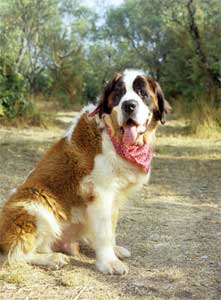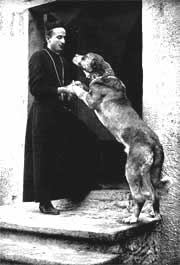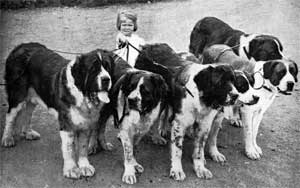
 Gentle Giants: St. Bernards are very gentle giants. They are often fond of children and are loyal to their family, but, as with any dog, should not be left unsupervised with young children. It is highly recommended that owners be very patient because this breed of dog can be very stubborn. It is imperative that St. Bernards should also remain very socialized because they can become overly protective of their territory. They are also very prone to anxiety if left alone for long periods of time and may destroy their owner's belongings. It is recommended that a suitable safe environment be made available during times that the owner can not be home. This could range anywhere from a fenced yard to a suitably sized crate (normally Extra Large). They commonly get along very well with other dogs and love high amounts of attention. Gentle Giants: St. Bernards are very gentle giants. They are often fond of children and are loyal to their family, but, as with any dog, should not be left unsupervised with young children. It is highly recommended that owners be very patient because this breed of dog can be very stubborn. It is imperative that St. Bernards should also remain very socialized because they can become overly protective of their territory. They are also very prone to anxiety if left alone for long periods of time and may destroy their owner's belongings. It is recommended that a suitable safe environment be made available during times that the owner can not be home. This could range anywhere from a fenced yard to a suitably sized crate (normally Extra Large). They commonly get along very well with other dogs and love high amounts of attention.
Health Issues: The very fast growth rate and the weight of a St Bernard can lead to very serious deterioration of the bones if the dog does not get proper food and exercise. Many dogs are affected by hip dysplasia. St Bernards are prone to an eye disorder called entropion and ectropion. The breed is also susceptible to epilepsy and seizures, a heart disease called dilated cardiomyopathy, and to eczema.

 Holy Dogs: The ancestors of the St. Bernard were the herding dogs of Swiss farmers as well as hunting dogs and watchdogs. Their history has also been connected with the hospice at the Great St. Bernard Pass. First reports of the dogs' presence at the pass date to the 17th century, and they remained loyal companions to the monks there until 2004, when the monks began to divest themselves of the dogs and focus the time they spent on the dogs to minister to people. Holy Dogs: The ancestors of the St. Bernard were the herding dogs of Swiss farmers as well as hunting dogs and watchdogs. Their history has also been connected with the hospice at the Great St. Bernard Pass. First reports of the dogs' presence at the pass date to the 17th century, and they remained loyal companions to the monks there until 2004, when the monks began to divest themselves of the dogs and focus the time they spent on the dogs to minister to people.
Mr. Popularity: The most famous St. Bernard to save people at the pass was Barry (sometimes spelled Berry), who reportedly saved somewhere between 40 and 100 lives. There is a monument to Barry in the Cimetière des Chiens and his body was preserved in the Natural History Museum in Berne.
Longhaired Hippies: The St. Bernard originally was a smooth-coated dog developed to rescue travelers from the snow. In the 1830s the monks who owned and bred the dogs introduced Newfoundland blood to strengthen the breed, and this gave rise to the rough-coat St. Bernard. Although more popular, the rough-coat variety proved to be unsuitable for mountain work because the long hair tended to collect icicles. For this reason the monks kept the smooth coat variety for rescue work.
The name "St. Bernard" was not in widespread use until the middle of the 19th century. The dogs were called "Saint Dogs", "Alpenmastiff", or "Barry Dogs" before, and in parts of North America, they're still called "Saints".
A drop of Brandy: St. Bernards are often portrayed, especially in comics and cartoons, with small barrels of brandy worn around their necks. This was supposedly used to warm the victims that the dogs found. However, the monks deny that any St. Bernard has ever carried casks or small barrels around their necks; they believe that the origin of the image is an early painting. The monks did keep casks around for photographs by tourists.

All text is available under the terms
of the GNU Free Documentation License |
